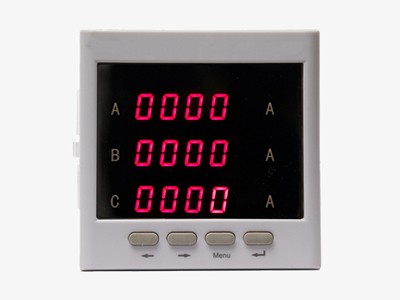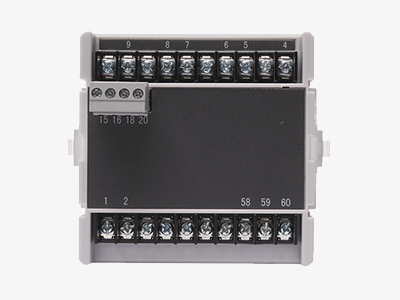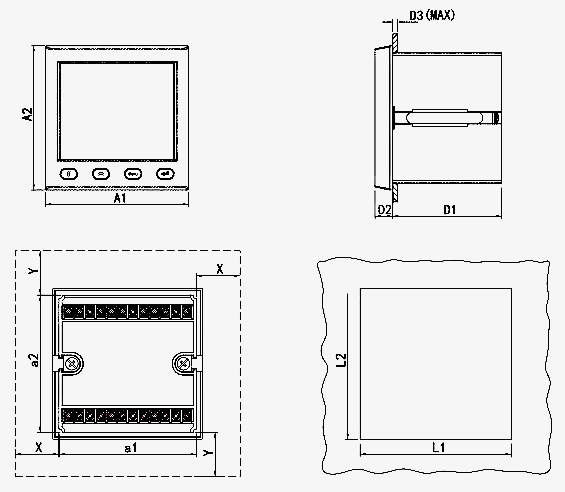sisco high precision digital panel voltmeter is suitable for the measurement of the three phase voltage parameters of the power distribution system. This display panel meter has programmable ratios, supports analog output and communication functions, and can directly replace analog pointer volt meters.

With large digital screen
Digital panel volt meter has a high-definition LED large digital tube screen, and the data is clear at a glance.

With terminal block
Digital panel volt meter has a terminal block for easy wiring and less power loss.
Applications
sisco digital panel volt meter can measure 3 phase AC voltage, which is widely used for control system, distribution network automation, new energy substation, industrial automation and intelligent building, energy management system, etc.

| Model | SISCO-PZ194U-□X4/□k4 | ||
| Level of Accuracy | 0.5 Level, 0.2 Level | ||
| Display | LED Display | ||
| Display Data Refresh Frequency | 1s | ||
| Input Characteristics | Voltage | Rated Value | AC 380V |
| Overload | Duration: 1.2Un, Instantaneous: 20Un/1min | ||
| Frequency | 45 ~ 65Hz | ||
| Auxiliary Power | Working Scope | AC 80 ~ 270V (50/60Hz), DC 80 ~ 270V, DC 24V/48V | |
| Power Consumption | ≤5VA | ||
| Switch Input | Dry Contact Mode | ||
| Relay Output | Contact Capacity (Resistive): AC 5A/250V, DC 5A/30V | ||
| Analog Output | DC 4 ~ 20mA, DC 0 ~ 20mA, etc., Load ≤350Ω | ||
| Communication | RS485 Interface, Modbus-RTU Protocol, Baud rate up to 9600bps | ||
| Protection Grade | Front Panel IP64, Rear Panel IP20 | ||
| Working Temperature | -40℃ ~ 70℃ (LED) | ||
| Relative Humidity | -40℃ ~ 85℃ (LED) | ||
| Absolute Ability | Power Supply, Input, Output≥AC2KV | ||
| Altitude | ≤2500m | ||
Dimensions (Unit: mm)

| Type | Panel Size (A1 x A2) |
Installation Size (a1 x a2) |
Cut-out Size (L1 x L2) |
Installation Depth (D1) |
Panel Thickness (D2) |
Installation Screen Thickness (D3 max) |
Reserved Size | |
| Horizontal (X) |
Vertical (Y) |
|||||||
| Type 2 | 120 x 120 | 110 x 110 | 111 x 111 | 55.5/76 | 15 | 5 | 10 | 20 |
| Type 3 | 83 x 83 | 75 x 75 | 76 x 76 | 75 | 12.5 | 5 | 10 | 20 |
| Type 5 | 96 x 48 | 90 x 43 | 91 x 44 | 68.5/82 | 10.5 | 10 | 40 | 20 |
| Type 9 | 96 x 96 | 90 x 90 | 91 x 91 | 75/98 | 13.5 | 10 | 40 | 20 |
| Type A | 74 x 74 | 66 x 66 | 67 x 67 | 75/90 | 12.5 | 5 | 10 | 20 |
| Type D | 48 x 48 | 44.5 x 44.5 | 45 x 45 | 89 | 9.5 | 5 | 40 | 20 |
Q1: What is a digital panel meter?
A1: The digital panel meter displays the voltage, current value or other standard signal transmission display value in the electrical circuit by digital direct reading; the product has the advantages of good stability, strong anti-interference, high cost performance, and the product is small in size and can be directly replaced original pointer meter.
Q2: What are the functions of digital panel meters?
A2: Digital panel meters can be categorized by type, size, style or other criteria. Understanding the functions of the digital panel meter is an important factor in choosing it. Commonly used functions are ammeters, voltmeters, frequency meters, power meters, energy meters, counters, timers, thermometers, process meters and controllers.
Q3: What are the advantages of digital panel meters?
A3: The digital panel meter directly displays the measured value or deviation value by digital quantity, which is clear and intuitive, easy to read, and will not produce parallax. Digital panel meters generally use large and medium-scale integrated circuits, with simple circuits, good reliability and good shock resistance. Because of the common modular design method for instruments, that is, digital panel meters are mostly composed of a small number of modular circuits with separated functions, so they are conducive to manufacturing, debugging and maintenance.
Tips: How to use a digital panel volt meter?
- Before use, the digital panel volt meter needs to be powered on for 15 minutes.
- Pay attention to prevent vibration and shock, and do not use it in places with too much dust and harmful gases.
- If the signal is accompanied by high frequency interference, a low frequency filter should be tried online.
- When not in use for a long time, please turn on the power every three months for no less than 4 hours.
- If there is no display on the digital panel voltmeter, first check that the auxiliary power and voltage are within range.
- If the display is abnormal, please check whether the input signal is normal and whether the signal terminals are tightened.
- If the voltmeter needs to be calibrated, the calibration meter should be better than class 0.1 to ensure calibration accuracy.
Thank you for buying industrial test and measurement equipment on SISCO.com, all products sold by SISCO and the partner cover a 12 months warranty, effective from the date of receiving the products.
What is covered?
SISCO is responsible for providing free spare parts, and free technical support to assist the customer to repair the defective products until the problem is solved.
What is not covered?
- Product purchased from anyone other than a SISCO store or a SISCO authorized reseller.
- Expendable parts.
- Routine cleaning or normal cosmetic and mechanical wear.
- Damage from misuse, abuse or neglect.
- Damage from use of parts other than SISCO approved.
- Damage from use outside the product’s usage or storage parameters.
- Damage from use of parts not sold by SISCO.
- Damage from modification or incorporation into other products.
- Damage from repair or replacement of warranted parts by a service provider other than a SISCO authorized service provider.
- Damage caused by the application environment not meeting the product usage requirements and the failure to perform preventive maintenance.

